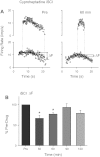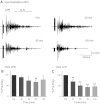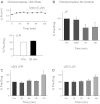Constitutively active 5-HT2/α1 receptors facilitate muscle spasms after human spinal cord injury
- PMID: 23221402
- PMCID: PMC3602940
- DOI: 10.1152/jn.00821.2012
Constitutively active 5-HT2/α1 receptors facilitate muscle spasms after human spinal cord injury
Abstract
In animals, the recovery of motoneuron excitability in the months following a complete spinal cord injury is mediated, in part, by increases in constitutive serotonin (5-HT2) and norepinephrine (α1) receptor activity, which facilitates the reactivation of calcium-mediated persistent inward currents (CaPICs) without the ligands serotonin and norepinephrine below the injury. In this study we sought evidence for a similar role of constitutive monoamine receptor activity in the development of spasticity in human spinal cord injury. In chronically injured participants with partially preserved sensory and motor function, the serotonin reuptake inhibitor citalopram facilitated long-lasting reflex responses (spasms) previously shown to be mediated by CaPICs, suggesting that in incomplete spinal cord injury, functional descending sources of monoamines are present to activate monoamine receptors below the lesion. However, in participants with motor or motor/sensory complete injuries, the inverse agonist cyproheptadine, which blocks both ligand and constitutive 5-HT2/α1 receptor activity, decreased long-lasting reflexes, whereas the neutral antagonist chlorpromazine, which only blocks ligand activation of these receptors, had no effect. When tested in noninjured control participants having functional descending sources of monoamines, chlorpromazine was effective in reducing CaPIC-mediated motor unit activity. On the basis of these combined results, it appears that in severe spinal cord injury, facilitation of persistent inward currents and muscle spasms is mainly mediated by the activation of constitutive 5-HT2 and α1 receptor activity. Drugs that more selectively block these constitutively active monoamine receptors may provide better oral control of spasticity, especially in motor complete spinal cord injury where reducing motoneuron excitability is the primary goal.
Figures





Similar articles
-
Constitutive activity of 5-HT2C receptors is present after incomplete spinal cord injury but is not modified after chronic SSRI or baclofen treatment.J Neurophysiol. 2017 Nov 1;118(5):2944-2952. doi: 10.1152/jn.00190.2017. Epub 2017 Sep 6. J Neurophysiol. 2017. PMID: 28877964 Free PMC article.
-
Reduction of spinal sensory transmission by facilitation of 5-HT1B/D receptors in noninjured and spinal cord-injured humans.J Neurophysiol. 2013 Mar;109(6):1485-93. doi: 10.1152/jn.00822.2012. Epub 2012 Dec 5. J Neurophysiol. 2013. PMID: 23221401 Free PMC article. Clinical Trial.
-
Adrenergic receptors modulate motoneuron excitability, sensory synaptic transmission and muscle spasms after chronic spinal cord injury.J Neurophysiol. 2011 Jan;105(1):410-22. doi: 10.1152/jn.00775.2010. Epub 2010 Nov 3. J Neurophysiol. 2011. PMID: 21047936 Free PMC article.
-
Persistent inward currents in motoneuron dendrites: implications for motor output.Muscle Nerve. 2005 Feb;31(2):135-56. doi: 10.1002/mus.20261. Muscle Nerve. 2005. PMID: 15736297 Review.
-
Mechanisms of Different Motor Neurons in the Occurrence of Spasticity After Spinal Cord Injury: A Narrative Review.Int J Mol Sci. 2025 May 28;26(11):5162. doi: 10.3390/ijms26115162. Int J Mol Sci. 2025. PMID: 40507976 Free PMC article. Review.
Cited by
-
Sustained involuntary muscle activity in cerebral palsy and stroke: same symptom, diverse mechanisms.Brain Commun. 2019 Nov 25;1(1):fcz037. doi: 10.1093/braincomms/fcz037. eCollection 2019. Brain Commun. 2019. PMID: 33033798 Free PMC article.
-
Constitutive activity of 5-HT2C receptors is present after incomplete spinal cord injury but is not modified after chronic SSRI or baclofen treatment.J Neurophysiol. 2017 Nov 1;118(5):2944-2952. doi: 10.1152/jn.00190.2017. Epub 2017 Sep 6. J Neurophysiol. 2017. PMID: 28877964 Free PMC article.
-
5-HT2 receptor antagonism reduces human motoneuron output to antidromic activation but not to stimulation of corticospinal axons.Eur J Neurosci. 2022 Jul;56(1):3674-3686. doi: 10.1111/ejn.15672. Epub 2022 Apr 27. Eur J Neurosci. 2022. PMID: 35445439 Free PMC article. Clinical Trial.
-
Animal models of developmental motor disorders: parallels to human motor dysfunction in cerebral palsy.J Neurophysiol. 2019 Sep 1;122(3):1238-1253. doi: 10.1152/jn.00233.2019. Epub 2019 Aug 14. J Neurophysiol. 2019. PMID: 31411933 Free PMC article.
-
Effect of fluoxetine on disease progression in a mouse model of ALS.J Neurophysiol. 2014 Jun 1;111(11):2164-76. doi: 10.1152/jn.00425.2013. Epub 2014 Mar 5. J Neurophysiol. 2014. PMID: 24598527 Free PMC article.
References
-
- Baker LL, Chandler SH. Characterization of postsynaptic potentials evoked by sural nerve stimulation in hindlimb motoneurons from acute and chronic spinal cats. Brain Res 420: 340–350, 1987 - PubMed
-
- Barbeau H, Filion M, Bedard P. Effects of agonists and antagonists of serotonin on spontaneous hindlimb EMG activity in chronic spinal rats. Neuropharmacology 20: 99–107, 1981 - PubMed
-
- Basmajian JV, Szatmari A. Effect of Largactil (chlorpromazine) on human spasticity and electromyogram. Arch Neurol Psychiatry 73A: 224–231, 1955 - PubMed
-
- Bennett DJ, Li Y, Siu M. Plateau potentials in sacrocaudal motoneurons of chronic spinal rats, recorded in vitro. J Neurophysiol 86: 1955–1971, 2001 - PubMed
Publication types
MeSH terms
Substances
Grants and funding
LinkOut - more resources
Full Text Sources
Other Literature Sources
Medical

